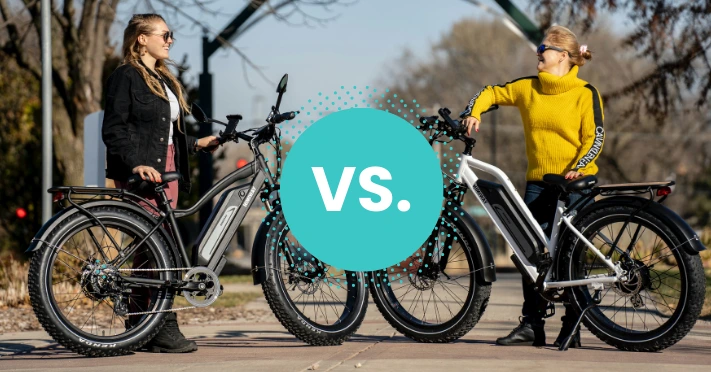Many electric bikes look like their traditional cousins, with their motors and batteries subtly hidden inside increasingly sleek frames. So a class system has been introduced to differentiate between the different categories of e-bikes. But what differentiates a Class 1 e-bike from a Class 2, which should you choose, and why?
What is the E-Bike Class System?
When riders started hitting roads, mountains, and dirt trails on e-bikes, it’s fair to say they turned a lot of heads and weren’t immediately welcomed. However, the introduction of regulations to govern electric bikes on local streets and trails has helped win people over and seen a surge in popularity. It’s also enabled more people to enjoy cycling instead of using their car or motorbike.
This move started in 2014, led by PeopleForBikes, the national advocacy group and bicycle industry trade association. Over 30 states have now introduced standardized regulations for e-bike usage using a three-class system. It defines simple classes of e-bikes based on operation, speed, and wattage, regulates the types of permitted bicycle infrastructure, and requires manufacturers to clearly demonstrate the e-bike’s class. More states are following suit as the system’s benefits in eliminating confusion, enhancing safety, and promoting green transportation methods.
Choosing Between Class 1 And Class 2 E-Bikes
With that in mind, let’s explore what the e-bike classifications mean for riders and the differences between them. It’s also worth noting that all classes of e-bikes are limited to one horsepower, which means electric motors with no more than 750W. Beyond Class 1 and 2 e-bikes, it’s also possible to purchase Class 3 and 4 vehicles, which may exceed the speed limits regulated by local authorities and may not be street-legal.
What Is a Class 1 E-Bike?
A Class 1 e-bike is limited to a top speed of 20 mph and has no throttle. That means the extra kick provided by the built-in electric motor is only activated when you’re pedaling the bike. This system, known as pedal assist, means that the motor will kick on and help you hit a top speed of 20 mph.
Class 1 e-bikes can generally co-exist alongside traditional non-electric bikes. They add a little assistance when climbing steep hills or extra pace when required. As a result, a Class 1 e-bike can be ridden anywhere that you’d ride a regular bike, including bike paths, bike lanes, and roads.
What Is a Class 2 E-Bike?
A Class 2 e-bike is also limited to 20mph, but the key difference is that these bikes have a throttle. That means the motor provides an additional power boost without pedaling the bike. The throttle feature irks some traditional riders, giving them further assistance up hills or trick trails even when they’re not putting much effort in.
An e-bike throttle typically comes via a grip twist or a button that sees the bike accelerate without pedaling. However, the throttle is limited to 20 mph to comply with safety regulations.
It’s worth noting that some manufacturers offer Class 2 e-bikes with uprated throttles that can offer a top speed of 28 mph. These are “out of class” e-bikes that are sometimes sold as Class 2, with the owner deciding how to set it up (whether that’s road legal or not).
Understanding E-Bike Road Usage
Before purchasing any electric bike, it’s essential to understand where and when you’ll be allowed to ride it under state laws. The increased popularity of electric bikes is seeing regulations around their usage evolving and generally becoming less restrictive.
In 2002, the US Congress passed the HB 727 regulation. This defined a “low-speed electric bicycle” as a two- or three-wheeled vehicle with fully operable pedals, an electric motor not exceeding 750W, and couldn’t achieve speeds over 20 mph. However, local state authorities increasingly have different regulations in place.
For example, a California rule states that Class 1 and 2 e-bikes can be operated by riders of any age on bikeways and bike lanes. Class 3 e-bike riders must be over 16, wear a helmet, and can use the vehicles in bike lanes that are part of public roads. Other states typically treat all three e-bike classes as bicycles but have variations around age limits, bikeway usage, and helmet requirements.
Finding The Right E-Bike
Now that you understand the difference between each class, the next step is to purchase the right e-bike for you. This decision depends on how and where you intend to ride it. There’s a wide range of e-bikes available, from road bikes and hybrid offerings to electric mountain bikes.
However, understanding classification is critical before purchasing an e-bike and hitting your local road or dirt trail. It’s vital to check which regulations your state has around e-bikes. We recommend referring to PeopleForBikes, which offers an excellent, frequently updated resource of state-by-state laws.

